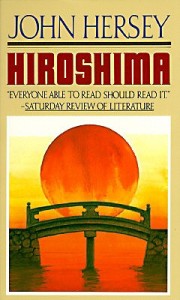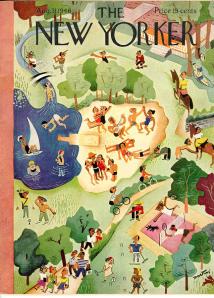John Hersey, Hiroshima (1946/1985)
 John Hersey’s Hiroshima originally appeared in (in fact, constituted the whole of) the August 31, 1946 issue of The New Yorker; it was published as a book later that year, and the edition I have includes a fifth chapter, “Aftermath,” written forty years after the dropping of the bombs in 1945. It tracks the experience of six survivors (or, more properly, hibakusha—literally, explosion-affected people): Miss Toshinki Sasaki, a young clerk; Dr. Masakazu Fujii, a physician who owned a private hospital; Mrs. Hatsuyo Nakamura, a widow with three children; Father Wilhelm Kleinsorge, a German priest; Dr. Terufumi Sasaki, a surgeon in the Red Cross Hospital; and Reverand Kiyoshi Tanimoto, a pastor of the Hiroshima Methodist Church.
John Hersey’s Hiroshima originally appeared in (in fact, constituted the whole of) the August 31, 1946 issue of The New Yorker; it was published as a book later that year, and the edition I have includes a fifth chapter, “Aftermath,” written forty years after the dropping of the bombs in 1945. It tracks the experience of six survivors (or, more properly, hibakusha—literally, explosion-affected people): Miss Toshinki Sasaki, a young clerk; Dr. Masakazu Fujii, a physician who owned a private hospital; Mrs. Hatsuyo Nakamura, a widow with three children; Father Wilhelm Kleinsorge, a German priest; Dr. Terufumi Sasaki, a surgeon in the Red Cross Hospital; and Reverand Kiyoshi Tanimoto, a pastor of the Hiroshima Methodist Church.
I was struck by the way that Hersey was providing an audience relatively ignorant about the delayed and long-term effects of radiation exposure with a narrative account of fallout—by the way that his piece connects the precipitating event (the dropping of uranium bomb “Little Boy” on August 6, 1945) with the delayed and  extended effects of this experience, with the narrative connection between surviving an atomic bomb and discovering the postponed medical damage over the course of the next few days, months, and (with the addition of the fifth chapter) decades. Hiroshima constructs the concept of the “risk factor.” What interests me is that Hersey subtly equates the medical with the cultural in terms of fallout, presenting delayed mental and emotional damage alongside delayed physical harm. Take, for instance, the way that he closed Chapter 4 (which was, for readers from 1946-1984, the end of the entire piece):
extended effects of this experience, with the narrative connection between surviving an atomic bomb and discovering the postponed medical damage over the course of the next few days, months, and (with the addition of the fifth chapter) decades. Hiroshima constructs the concept of the “risk factor.” What interests me is that Hersey subtly equates the medical with the cultural in terms of fallout, presenting delayed mental and emotional damage alongside delayed physical harm. Take, for instance, the way that he closed Chapter 4 (which was, for readers from 1946-1984, the end of the entire piece):
It would be impossible to say what horrors were embedded in the minds of the children who lived through the day of the bombing in Hiroshima. On the surface, their recollections, months after the disaster, were of an exhilarating adventure. (90)
He concludes this paragraph with a quotation from an essay written by Hatsuyo Nakamura’s son Toshio about the bomb. The effect is chilling: having focused on the embedding of radiation damage and unknown medical dangers that may surface in the future, Hersey wraps up by creating a new category of fallout, one that is psychological and social rather than medical or physical. The structure he has built of delayed damage is repurposed to account for a new kind of danger.
This is made even more complicated in the final chapter, where Hersey describes the long-term ailments of the hibakusha:
…most of them seemed to suffer … from the mysterious that real malaise that came to be known as one kind of lasting A-bomb sickness: a nagging weakness and weariness, dizziness now and then, digestive troubles, all aggravated by a feeling of oppression, a sense of doom, for it was said that unspeakable diseases might at any time plant nasty flowers in the bodies of their victims, and even in those of their descendants. (93)
There is much to comment on here—I’m particularly fascinated by the notion of diseases as “nasty flowers” whose seeds have been sown by nuclear exposure, a botanical nightmare that calls back to the menacing explosion of flora in the “Panic Grass and Feverfew” chapter—but what I would like to focus on is how the final symptom Hersey discusses is precisely the kind of emotional fallout that I have been arguing he constructs: the emotional fallout of the knowledge that you are subject to mysterious symptoms that you may be unable to predict, to resolve, to receive compensation for, to protect your progeny from, or even to conclusively link to radiation exposure. I feel there’s a connection between this alarming account of the two kinds of fallout and Hersey’s description later in the same chapter of Toshinki Sasaki’s reflections: she had
focus on is how the final symptom Hersey discusses is precisely the kind of emotional fallout that I have been arguing he constructs: the emotional fallout of the knowledge that you are subject to mysterious symptoms that you may be unable to predict, to resolve, to receive compensation for, to protect your progeny from, or even to conclusively link to radiation exposure. I feel there’s a connection between this alarming account of the two kinds of fallout and Hersey’s description later in the same chapter of Toshinki Sasaki’s reflections: she had
an opinion that was unconventional for a hikabusha: that too much attention was paid to the power of the A-bomb, and not enough to the evil of war. Her rather bitter opinion was that it was the more lightly affected hikabusha and power-hungry politicians who focused on the A-bomb, and that not enough thought was given to the fact that warfare had indiscriminately made victims of Japanese who had suffered atomic and incendiary bombings, Chinese citizens who had been attacked by the Japanese, reluctant young Japanese and American soldiers who were drafted to be killed or maimed, and, yes, Japanese prostitutes and their mixed-blood babies. She had firsthand knowledge of the cruelty of the atomic bomb, but she felt that more notice should be given to the causes than to the instruments of total war. (122)
Hersey’s focus on the cultural/social comes full circle here: just as the cultural symptoms of fallout are emphasized, so too are the cultural causes of fallout of primary interest to Sasaki (even if, as he points out, this opinion is in the minority). I’ll wrap up by pointing to possible connections between this emphasis and Hersey’s statement, via Nakamura’s experience, that “The bombing almost seemed a natural disaster” (93). A natural disaster cannot be blamed or avoided; all we can do is respond. I’m not sure what to make of the politics that this suggests. Is this a comforting way of distancing American readers from national guilt? Is this an effort to dissociate atomic energy from weaponry in the service of emphasizing possible peacetime uses? Is this an incisive assessment of global infrastructure and a call for global peace? Mary McCarthy’s critique would suggest the first reading: that Hersey was domesticating the bomb and placating an American readership by presenting the bombing as a banal occasion for a natural disaster narrative; Paul Boyer, on the other hand, finds this critique overstated, particularly in the context of other contemporaneous accounts (making Hersey’s text a new kind of narrative in a culture already saturated with broad statistics and American accountability). I not only see both sides, but also see the interaction of the viewpoints: in other words, it is precisely Hersey’s sensitive and novel account of delayed effects that sets up his slippage into the language of natural disaster. Is this, as Hersey’s critics claimed, necessarily an effect of naturalism? I don’t think so. But it is his attention to delayed damage that simultaneously sets up a new temporal paradigm whose importance cannot be overstated and allows the event itself to fade into the background.
